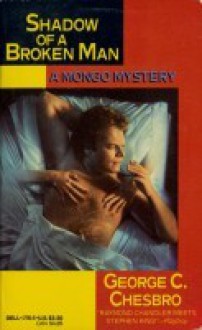
For my full review, please visit Casual Debris.
George C. Chesbro's semi-popular dwarf private detective, lecturer and criminologist Dr. Robert Frederickson, better known as retired circus acrobat "Mongo the Magnificent," first appeared in various magazines in the early 1970s, most notably Alfred Hitchcock's Mystery Magazine and Mike Shayne's Mystery Magazine. Chesbro was fundamentally a mystery writer, but much of his work was infused with elements of the supernatural, as were the Mongo novels. AHMM was not averse to publishing mysteries that contained elements of the supernatural, and featured many mixed genre mystery stories, including a handful by Chesbro himself. The novella that was the basis for the first Mongo novel, Shadow of a Broken Man, was titled "Strange Prey" (Alfred Hitchcock's Mystery Magazine, August 1970), and featured the plight of telepathic New York architect Victor Rafferty. The novella predates "Mongo," and did not feature an investigating detective of any kind, but instead pursued Rafferty's plight from agents wanting to recruit him for talents that could help transform him into a natural, undetectable super-spy.
Shadow of a Broken Man is set several years following the events of "Strange Prey." Detective Mongo is hired to find the missing architect. For those reading the novel without having read the novella, the secret to Rafferty's disappearance is one discovered alongside our detective's own investigations, while those who have read the novella are aware of many of the facts Mongo is in the process of unveiling, and there is less suspense offered to the reader. I had read "Strange Prey" a number of years ago, but was not aware of its connection to the novel, and only when I was well into the book did I realize that the elusive Victor Rafferty was the sympathetic character in Chesbro's novella, which as a pre-teen was among my favourite AHMM stories.
Most striking between the two narratives is the perception of character. In the shorter version we read of Rafferty's experiences coping with his new powers, whereas in the novel we are quite removed from the man, and he comes across as cold and confident, not at all the sympathetic anti-hero of the earlier version. Of course the novel is set years later when Rafferty has taken on a new identity, has properly trained himself to control his powers and, most importantly, has found a purpose in life for his new, "improved" self. Moreover, this change is actually properly in tune with where Rafferty, having made a decision to take charge of his fate at the end of "Strange Prey," is expected to find himself years later. Otherwise the stories are closely connected, and the novel for most part, even in smaller details, follows the events of "Strange Prey" quite accurately.
Shadow of a Broken Man begins as a conventional mystery, as Mongo is hired by the former Mrs. Rafferty's new husband to investigate the possibility that Mr. Rafferty is still alive. Our detective follows the expected path in interviewing and investigating, and it isn't until we're quite drawn into the case that the reader becomes aware that there is a supernatural element involved, and even later as to the extent of that element. The work is quite solid and satisfying, and though I like "Strange Prey" and loved it as a kid, I do wonder how I would have responded to the novel not knowing the nature of our mysterious Rafferty; namely how I would have responded to the supernatural element and its introduction into the mystery.
To be continued...For my complete review, please visit Casual Debris.

 Log in with Facebook
Log in with Facebook 






